armscye
One of the Regulars
- Messages
- 143
- Location
- New England
With warm weather in New England, the jacket hunting bug has bit again. Last week came my first score of the season, but with more than its share of mysteries.
In a rack of flea market treasures I found the dusty remnants of an A2, looking initially very non-milspec because of the obvious texture of the leather. Even from five yards away, the jacket had the striations and surface pebbling of lamb or cape. Still, as I approached I noted a mil-style throat latch and two piece sleeves.
My puzzlement began to deepen as I examined this dingy dog. It looked totally milspec in cut and details-- trim dimensions, one piece back, brown drill lining albeit without label, and a brass Ideal zipper. Still, no military flight jacket since 1931 has specified capeskin, and the leather was clearly that, not goat, cow, or horsehide. The broad one-piece back looked too wide to have come from even a lamb on steroids. There was a civilianish snap at the bottom of the windflap, but that could have been added by any local luggage repairman.
I asked the price, quick drew my wallet when I heard "five bucks", and headed for home to examine my treasure.
Regular readers will know I machine wash all my jackets, so I ran this one through my usual regimen of cold water front load wash with woolite, followed by leisurely air drying and hide reconditioning. Once cleaned up, the mystery intensified.
Based on the zipper, the pointed disco style collar, the leathercraft care label, the stitch holes outlining the missing label and two Velcro chest patches—one shield shaped, one rectangular--, and the pocket sew pattern, I concluded that I had found a first contract USAF Saddlery Cooper A2, probably in size 44, vintage circa 1988. Not only were civilian jackets not fitted with the Velcro, but the label residue indicates two stacked rectangles of similar size, characteristic of a Saddlery jacket, and definitely does not match the civilian orange label Coopers of that era.
All of which raises more questions than answers. Would any Air Force purchasing agent have authorized capeskin, even in the busy run-up to Desert Storm? Were USAF Saddlery jackets issued after inspection, or just sold at the PX, where violations of material specs might not be noticed? Could Cooper have delivered heavily pressed capeskin jackets, hoping they'd pass as goat? I invite commentary and speculation from Loungers.
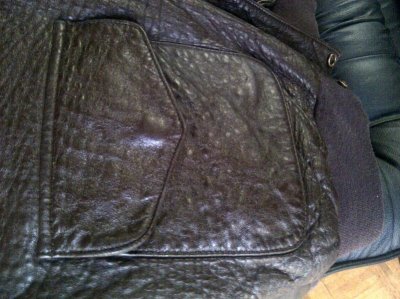
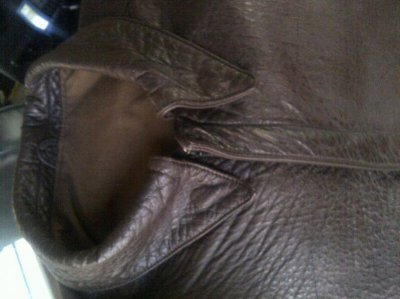
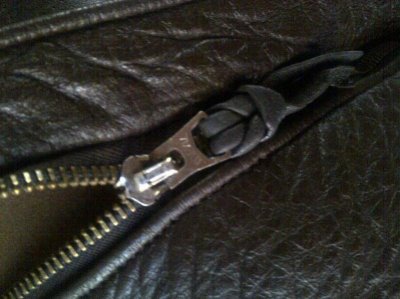
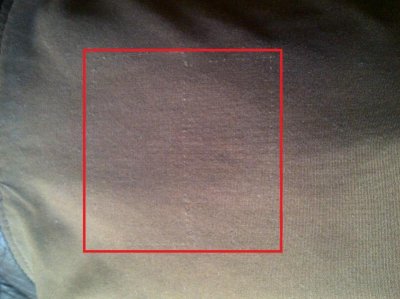
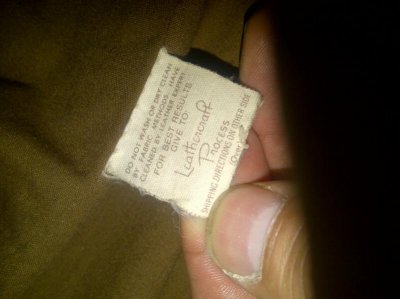
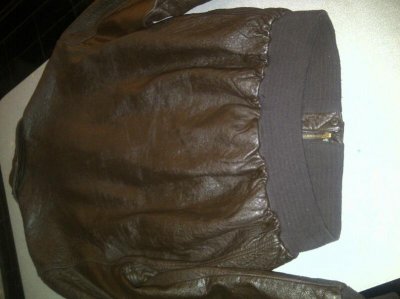
In a rack of flea market treasures I found the dusty remnants of an A2, looking initially very non-milspec because of the obvious texture of the leather. Even from five yards away, the jacket had the striations and surface pebbling of lamb or cape. Still, as I approached I noted a mil-style throat latch and two piece sleeves.
My puzzlement began to deepen as I examined this dingy dog. It looked totally milspec in cut and details-- trim dimensions, one piece back, brown drill lining albeit without label, and a brass Ideal zipper. Still, no military flight jacket since 1931 has specified capeskin, and the leather was clearly that, not goat, cow, or horsehide. The broad one-piece back looked too wide to have come from even a lamb on steroids. There was a civilianish snap at the bottom of the windflap, but that could have been added by any local luggage repairman.
I asked the price, quick drew my wallet when I heard "five bucks", and headed for home to examine my treasure.
Regular readers will know I machine wash all my jackets, so I ran this one through my usual regimen of cold water front load wash with woolite, followed by leisurely air drying and hide reconditioning. Once cleaned up, the mystery intensified.
Based on the zipper, the pointed disco style collar, the leathercraft care label, the stitch holes outlining the missing label and two Velcro chest patches—one shield shaped, one rectangular--, and the pocket sew pattern, I concluded that I had found a first contract USAF Saddlery Cooper A2, probably in size 44, vintage circa 1988. Not only were civilian jackets not fitted with the Velcro, but the label residue indicates two stacked rectangles of similar size, characteristic of a Saddlery jacket, and definitely does not match the civilian orange label Coopers of that era.
All of which raises more questions than answers. Would any Air Force purchasing agent have authorized capeskin, even in the busy run-up to Desert Storm? Were USAF Saddlery jackets issued after inspection, or just sold at the PX, where violations of material specs might not be noticed? Could Cooper have delivered heavily pressed capeskin jackets, hoping they'd pass as goat? I invite commentary and speculation from Loungers.








